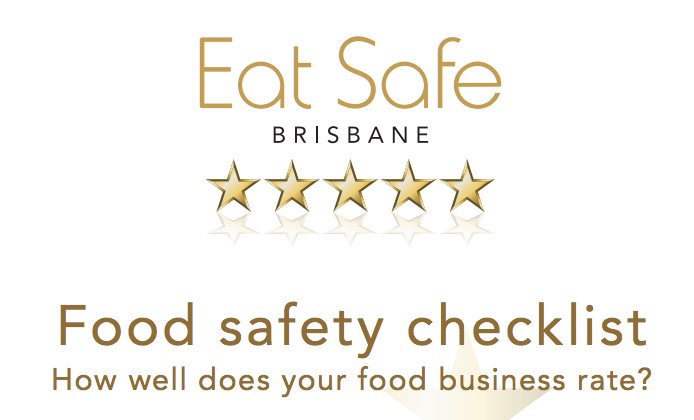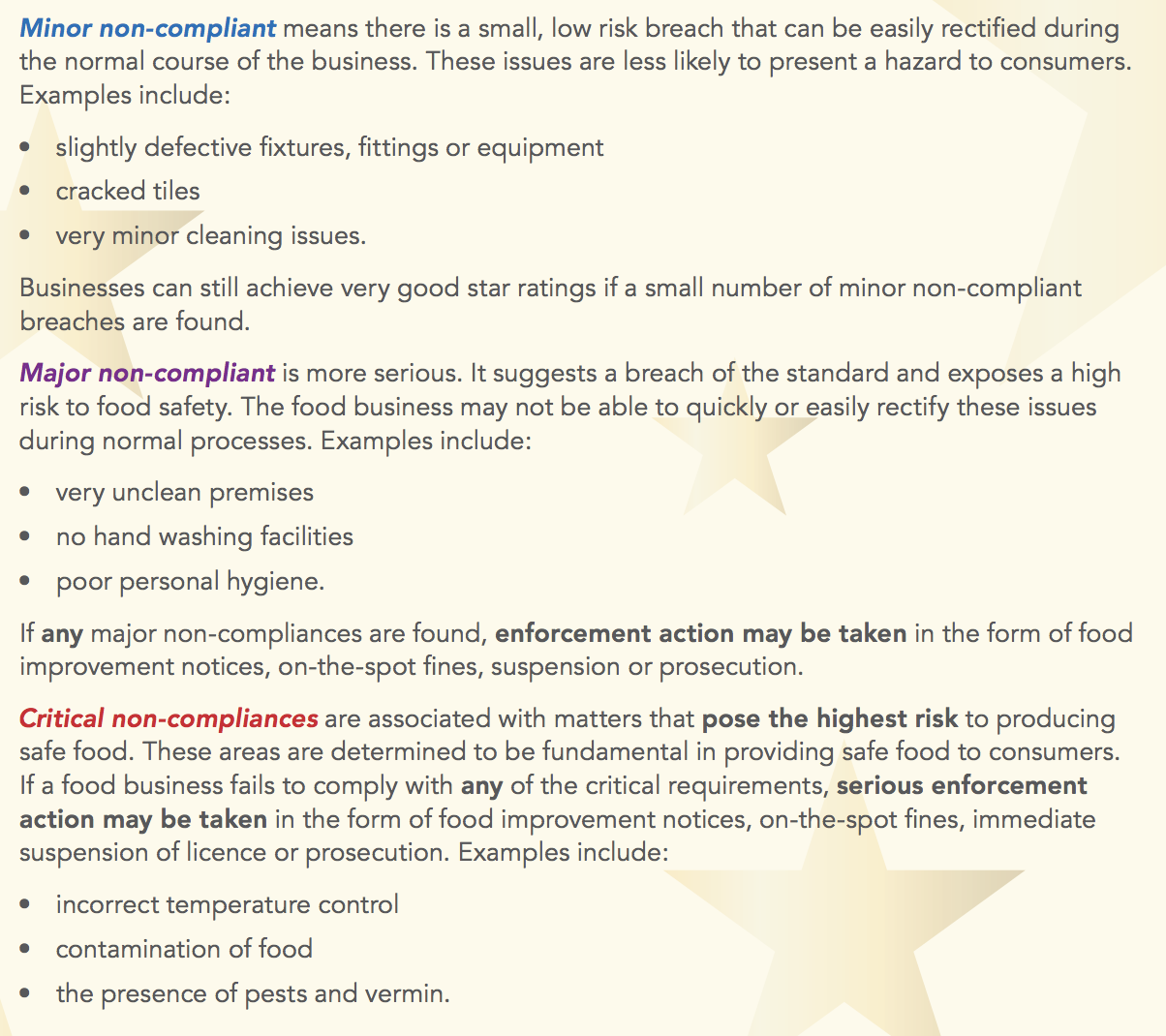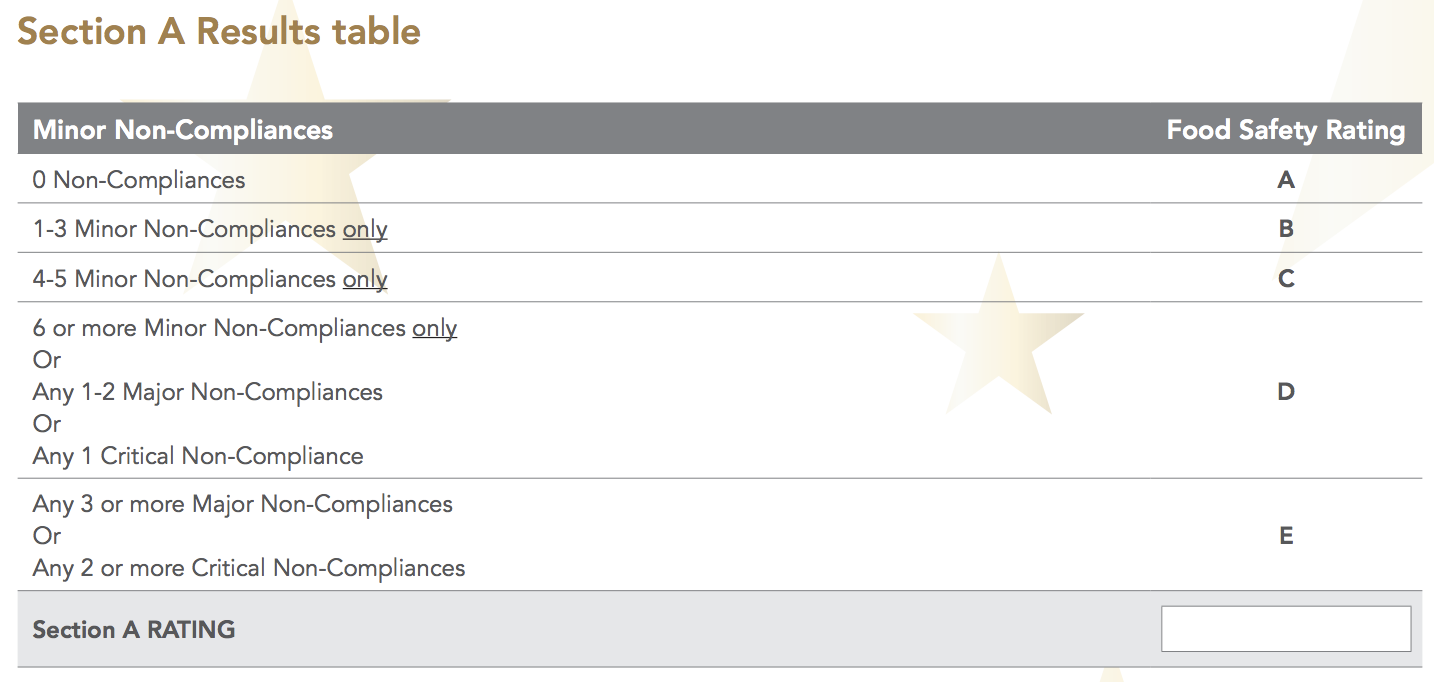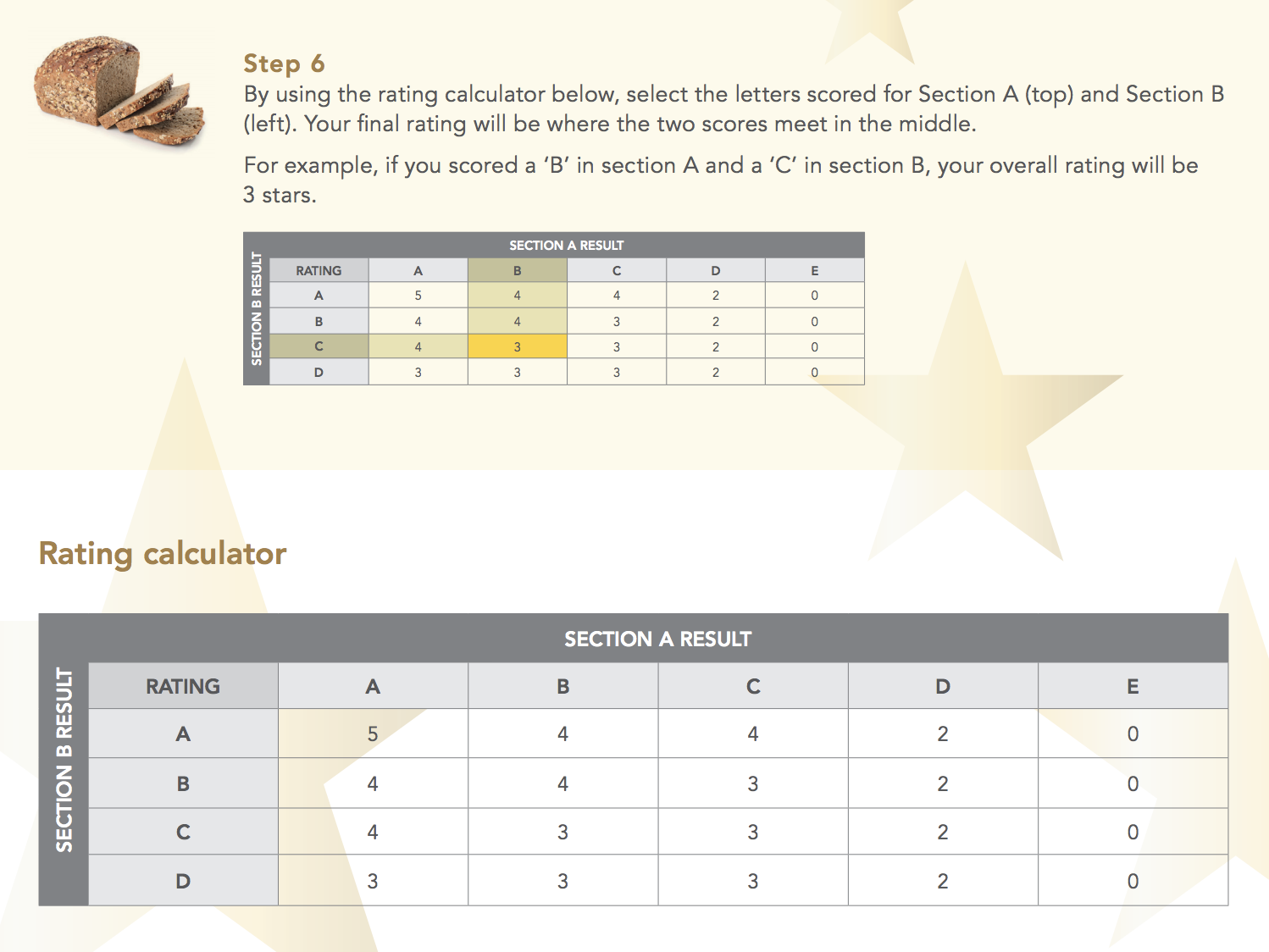Title Page
-
Business Name
-
Location
-
Food safety supervisor
-
Conducted on
How to use this checklist
-
-
Under Council’s Eat Safe Brisbane food safety rating scheme, all licensed food businesses within Brisbane will be issued with a food safety star rating. These will be based on an assessment conducted by Council under the Food Act 2006 and good management practices.
The scheme was introduced to protect the health and well-being of residents and visitors.
Use this checklist to assess your current food safety processes and work out an approximate Eat Safe Brisbane food safety rating. This checklist should be used in conjunction with the Eat Safe Brisbane Food Safety Made Easy Guide which helps businesses achieve high levels of food safety.
A similar checklist, the Food Safety Audit Proforma, is used by Council officers during the regular food safety audit to assess your business’ food handling practices and procedures and also your Eat Safe Brisbane star rating.
The Eat Safe Brisbane Food Safety Made Easy Guide and further information about Eat Safe
Brisbane is available by clicking below. -
Learn more about Eat Safe Brisbane before you do your self assessment:
http://www.brisbane.qld.gov.au/EatSafeBrisbane
Section A - Compliance details
-
STEP 1
The food licensee or Food Safety Supervisor can complete this checklist. Complete the administration details at the top of the checklist (e.g. name, date) to keep a record for your information. -
STEP 2
Complete Section A in order – the checklist follows the typical flow of processing food from beginning to end (e.g. receive food, store food, process food, display/serve food). Section A contains Minor, Major and Critical Compliance areas. All of these areas must be complied with as part of the Food Act 2006 requirements. For definitions of these various compliance levels, refer to page 2 of this checklist.
If you believe your food business fully complies with each of the listed requirements, tick the ‘Yes’ box. If you are unsure, please refer to the Eat Safe Brisbane Food Safety Made Easy Guide. If you find areas that are not complying with the listed requirements, tick the appropriate Minor, Major or Critical box. Refer to the next page for a general guide to identifying minor and major compliance issues.
Please note that some requirements throughout the checklist may not be applicable to your particular food business due to the limited nature of your activity. -
Section A contains the food safety requirements outlined in the Food Act 2006 and the Food Safety Standards. It is the food business’ legal responsibility to comply with these. Any infringements of these provisions are noted and subsequently tallied to give an overall representation of the compliance against the Food Act 2006.
The three non-compliance selections within Section A represent the various levels of risk. -
The three non-compliance selections within Section A represent the various levels of risk.
Section B - Good management practices
-
Section B contains a list of management documents that identify and control food safety hazards in the handling of food in a food business. These documents are seen as effective tools in managing food safety risks associated with any food operation.
If a business can provide examples of these documents, Council will maintain confidence that the food business can operate at a higher level of compliance and reward the business through higher overall ratings.
The points associated with each management document kept are totalled to give the Section B score. These documents must be maintained on a frequent basis and kept on-site at all times.
Scores from both Section A and Section B are used to calculate the overall star rating. Free marketing material from Council will be provided to businesses who achieve 3 stars or more and decide to opt-in to publicly display their star rating.
Visit the link below for more information on how to achieve compliance and best practice.
https://www.brisbane.qld.gov.au/community-safety/community-safety/food-safety
Scoring instructions
-
Full information on how to score is at the end of this checklist and will also be displayed int he exported PDF report
Section A - General requirements
General Requirements
-
A1 Licence – Is your Council food business licence current? (See page 5 of Food Safety Made Easy Guide) i.e. no outstanding fees
-
A2 Licence – Is the current licence displayed prominently on the premises? (See page 5 of Food Safety Made Easy Guide)
-
A3 Licence Conditions – Is your business complying with all site specific licence conditions (if applicable)? (See page 5 of Food Safety Made Easy Guide)
-
A4 Previous non-compliances – Has your business fixed all previous non-compliance items? (See page 5 of Food Safety Made Easy Guide)
-
A5 Design – Does your business comply with the structural requirements of the Food Safety Standards? (See page 5 of Food Safety Made Easy Guide)
-
A6 Food Safety Supervisor – Have you notified Council who your Food Safety Supervisor is/are? (See page 6 of Food Safety Made Easy Guide)
-
A7 Food Safety Supervisor – Is the Food Safety Supervisor reasonably available/contactable? (See page 6 of Food Safety Made Easy Guide)
-
A8 Food Safety Program – If required, does your food business have an accredited Food Safety Program? (See page 7 of Food Safety Made Easy Guide) 4 | Food safety checklist Food Handling Controls Ref Control Measure Comments/Findings Compliant Yes No Minor Major Critical
Section A - Food Handling Controls
Food handling controls
-
A9 Skills and knowledge – Do you and your employees have appropriate skills and knowledge in food safety and hygiene matters? (See page 7 of Food Safety Made Easy Guide)
-
A10 Receival – Is food protected from contamination at receival and are potentially hazardous foods accepted at the correct temperature? (See page 8 of Food Safety Made Easy Guide)
-
A11 Food storage – Is all food stored appropriately so that it is protected from contamination? (See page 9 of Food Safety Made Easy Guide) <br>- cold room / fridge<br>- freezer<br>- dry store
-
A12 Food storage – Is potentially hazardous food stored under temperature control? (See page 9 of Food Safety Made Easy Guide) <br>- cold food = 5ºC and below <br>- hot food = 60ºC and above <br>- frozen food = remain frozen
-
A13 Food processing – Are suitable measures in place to prevent contamination? (See page 9 of Food Safety Made Easy Guide) e.g. cross contamination
-
A14 Food processing – Is potentially hazardous food that is ready to eat and held outside of temperature control monitored correctly? (See page 10 of Food Safety Made Easy Guide) e.g. 2 hour/4 hour rule
-
A15 Thawing – Are acceptable methods used to thaw food? (See page 10 of Food Safety Made Easy Guide)
-
A16 Cooling – Are acceptable methods used to cool food? (See page 11 of Food Safety Made Easy Guide)
-
A17 Reheating – Are appropriate reheating procedures followed? (See page 11 of Food Safety Made Easy Guide)
-
A18 Food display – Is food on display protected from contamination? (See page 11 of Food Safety Made Easy Guide)
-
A19 Food display – Is potentially hazardous food displayed under correct temperature control? (See page 12 of Food Safety Made Easy Guide) Food safety checklist | 5
-
A20 Food packaging – Is food packaged in a manner that protects it from contamination? (See page 12 of Food Safety Made Easy Guide)
-
A21 Food transportation – Is food transported in a manner that protects it from contamination and keeps it at the appropriate temperature? (See page 12 of Food Safety Made Easy Guide)
-
A22 Food for disposal – Do you use acceptable arrangements for throwing out food? (See page 13 of Food Safety Made Easy Guide)
-
A23 Food recall – If you are a wholesale supplier, manufacturer or importer of food, does your food business comply with the food recall requirements? (See page 13 of Food Safety Made Easy Guide)
-
A24 Alternative methods – Are your documented alternative compliance methods acceptable i.e. receipt, storage, cooling, reheating, display, transport? (See page 14 of Food Safety Made Easy Guide)
Section A - Health and Hygiene Requirements
-
A25 Contact with food – Does your business minimise the risk of contamination of food and foodcontact surfaces? (See page 15 of Food Safety Made Easy Guide)
-
A26 Health of food handlers – Do you ensure staff members do not engage in food handling if they are suffering from a food-borne illness or are sick? (See page 15 of Food Safety Made Easy Guide)
-
A27 Hygiene – Do food handler sexercise good hygiene practices (e.g. cleanliness of clothing, not eating over surfaces, washing hands correctly and at appropriate times, jewellery)? (See page 16 of Food Safety Made Easy Guide)
-
A28 Hand washing facilities – Does your business have adequate handwashing facilities? (See page 17 ofFood Safety Made Easy Guide)<br>- soap<br>- warm running water<br>- single-use towel<br>- easily accessible basin
Section A - Cleaning, sanitising, and maintenance
-
A29 Duty of food business – Do you inform food handlers oft heir obligations and take measures to ensure they do not contaminate food? (See page 17 of Food SafetyMade Easy Guide)
-
A30 Cleanliness – Are the floors, walls and ceilings maintained in a clean condition? (See page 18 of FoodSafety Made Easy Guide)
-
A31 Cleanliness – Are the fixtures, fittings and equipment maintained in a clean condition? (See page 19 of Food Safety Made Easy Guide)<br>- mechanical exhaust ventilation<br>- fridges, coolrooms, freezers<br>- benches, shelves, cooking equipment
-
A32 Cleanliness – Are the premises in general maintained in a clean condition? (See page 18 of Food Safety Made Easy Guide)
-
A33 Sanitation – Has your business provided clean and sanitary equipment including? (See page 19 of Food Safety Made Easy Guide)<br>- eating and drinking utensils<br>- food contact surfaces
-
A34 Sanitation – Are food contact surfaces of utensils and equipment sanitised correctly? (See page 19 of Food Safety Made Easy Guide)
-
A35 Maintenance – Does your business ensure no damaged (cracked/broken) utensils, crockery, cutting boards are used? (See page 19 of Food Safety Made Easy Guide)
-
A36 Maintenance – If you are responsible for maintaining the grease trap, is it serviced effectively? (See page 19 of FoodSafety Made Easy Guide)
-
A37 Maintenance – Are your premises, fixtures, fittings and equipment maintained in a good state of repair and working order? (See page 19of Food Safety Made Easy Guide)<br>- floors, walls & ceilings<br>- fixtures, fittings & equip<br>- mechanical exhaust ventilation
Section A - Miscellaneous
-
A38 Thermometer – Does your food business (if handling potentially hazardous food) have a thermometer? (See page 20 of Food Safety Made Easy Guide)
-
A39 Thermometer – Is the thermometer cleaned and sanitised between uses? (See page 21 of Food Safety Made Easy Guide)
-
A40 Single Use Items – Are single-use items protected from contamination until use and not used more than once? (See page 21 of Food Safety Made Easy Guide)
-
A41 Toilet – Are adequate staff toilets provided and in a clean state? (See page 21 of Food Safety Made Easy Guide)
-
A42 Animals and pests – Is your food business completely free from animals or vermin (assistance animals exempt)? (See page 21 of Food Safety Made Easy Guide)
-
A43 Animals and pests – Are animal sand pests prevented from being on the premises? (See page 21 of Food Safety Made Easy Guide)
-
A44 Animals and pests – Is pest control carried out at sufficient intervals to eradicate pests? (See page 21 of Food SafetyMade Easy Guide)
Section B - Good management practices
-
-
For more information, refer to the Eat Safe Brisbane - Food Safety Made Easy Guide
https://www.brisbane.qld.gov.au/sites/default/files/Eat_Safe_Brisbane_Food_Safey_Made_Easy_Guide.pdf -
Documented and Maintained Records (all records relevant to the business must be kept on site)
-
B1 Accredited HACCP Plan or ISO 22000:2005 (See page 24 of Food Safety Made Easy Guide - if YES, do not continue to check for other documentation)
-
B2 Accredited Food Safety Program (See page 25 of Food Safety Made Easy Guide - if YES, do not continue to check for other documentation)
-
B3 Cleaning Program and Schedule (See page 27 of Food Safety Made Easy Guide)
-
B4 Temperature Record – Food Display/Storage (See page 29 of Food Safety Made Easy Guide)
-
B5 Transportation Temperature Control (See page 31 of Food Safety Made Easy Guide)
-
B6 Products Received Temperature Record (See page 30 of Food Safety Made Easy Guide)
-
B7 Greater than 50% of food handlers trained in a recognised Training Course (See page 31 of Food Safety Made Easy Guide)
-
B8 Staff Training Records (internal and external training) (See page 32 of Food Safety Made Easy Guide)
-
B9 Maintenance Records (Structural and Equipment) (See page 33 of Food Safety Made Easy Guide)
-
B10 Pest Control Schedule (by a licensed contractor) (See page 35 of Food Safety Made Easy Guide)
-
B11 Waste Collection and Refuse Cleaning Record (See page 35 of Food Safety Made Easy Guide)
-
B12 Stock Rotation Schedule (See page 36 of Food Safety Made Easy Guide)
-
B13 NOTE: If a food business does not receive, store, display or process Potentially Hazardous Foods (PHF), add 10 bonus points 10
Scoring Instructions
Scoring instructions
-
Now that you've completed the checklist, scroll to the bottom and hit "Mark as Complete". Export your audit as a PDF and these instructions will be included at the bottom of the PDF to give you all of the information needed to calculate your score.
How to score Section A - Compliance
-
Using the "Failed Responses" section at the top of the PDF report , count the number of Minor, Major and Critical non-complaint areas separately and note the totals of each.
Calculate the Section A rating by selecting the A, B, C, D or E in the results table below. The A, B, C, D or E will be next to the number of non-compliances your business has recorded. -
How to score Section B - Good management practices
-
If you scroll up you will see "Section B - Good Management Practices" and this will have a score next to it, you can use this to inform the rating based on the table below.
-











